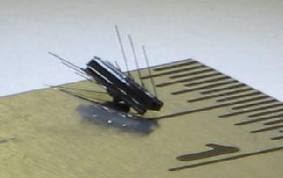This week’s class started with a discussion of the shift from silicon to plastic. Using plastic electronics or plastic technology, scientists are already showing signs of manufacturing an e-book that is made of plastic instead of the usual material, silicon. How amazing is that? Not only is it lighter and more flexible, it is less expensive than inorganic conductors!
Taking a step forward, if ipads can be made with this technology, one wouldn’t have to worry about damaging it accidentally plus it could be “rolled up” as shown in the picture above. Pretty nifty eh?
The possibilities of plastic are far-reaching. What if there are plastic clothing that can possibly monitor your health? How about a sofa with an in-built remote control that can change the channels with the press of the cushion seat? More importantly, we are on the holy grail of achieving the plastic microchip. Yet even if we achieve this, more plastics would mean more pollution since they are non-biodegradable unless bioplastics are used instead? Since we are currently already in the stage of making small-scale items such as cutlery, pots etc I believe that the day would eventually come where most of the silicon objects will be replaced by biodegradable plastics.
Moving on, there was the discussion of The Perfect Woman. Built in Japan to “fulfil the needs of men” and to “satisfy them” on an emotional and psychological level sounds outrageous. No doubt, robots are superior to humans in terms of getting the housework done since they don’t tire. However, it is laughable (I apologize for my harsh tone!) to classify them- at this stage- on the same level as actual human beings given the fact that they are void of emotions. What has happened to human connection and the human touch? Furthermore, commercializing it to meet the demands of the public seem a little too drastic at this point because it might possibly lead to a decrease in social contact. That said, it seems that online dating or match-making agencies will probably be going out of business soon…

I believe that using robotics to do menial work is perfectly acceptable. After all, it is dehumanising to let people do menial tasks when they actually have the capacity to do so. Menial tasks- basically anything that is labour-intensive- would include jobs such as road sweeping, giving out fliers perhaps? Time can be spent on spending time with family or engaging in more productive tasks. Furthermore, now that we are in the Information Age, the spread of data is so rampant. We should not be living as how we are living in the past.
This brings a social challenge- we have to re-evaluate the way we see things. Can we actually create a fair society that allows people to enjoy the things without doing silly menial jobs? What sort of ramifications will it lead to? Political turmoil? Ultimately, the question scientists and political figures have to address is whether automation have a place in today’s world.
The next invention that intrigued me was the use of biometrics. Hallelujah! Gone are the days where we have to bring cumbersome credit cards! I foresee a smaller wallet and more convenience. However, given that it is rather invasive in nature, detractors might be a little apprehensive.
This brings me to my next point of surveillance technology. Nanobots e.g. spy drones which are used to captures scenes from all around the world may be a boon for military warfare but it leads to privacy issue. Indeed, big brother is watching. The iball, which is created by our very own Singaporean entrepreneur, Henn Tan (which is the leader I am currently researching for my other mod, LTB) is a camera that is the size of a 50 cent coin. Even though it is handy, some decry that it is a restriction to personal freedom. What do you think?
Next is the innovation by SIEMENS: a total electrification of its vehicles. Providing a constant supply of electricity in a sustainable way, it is possible of powering an output of 200 gigawatts. Using the smart grid, which can be defined as:
An electrical grid is not a single entity but an aggregate of multiple networks and multiple power generation companies with multiple operators employing varying levels of communication and coordination, most of which is manually controlled. Smart grids increase the connectivity, automation and coordination between these suppliers, consumers and networks that perform either long distance transmission or local distribution tasks. § Transmission networks move electricity in bulk over medium to long distances, are actively managed, and generally operate from 345kV to 800kV over AC and DC lines. § Local networks traditionally moved power in one direction, "distributing" the bulk power to consumers and businesses via lines operating at 132kV and lower. (Wikipedia, 2010)
They are able to maximise efficiency and enhance performance of their electric vehicles. The electrical infrastructure is getting more interconnected.
Next, I would like to briefly discuss 2 of the topics brought up through presentations done by my classmates. The first is by Eileen Ng and her topic of 3D printing. I found this disruptive simply fascinating as it makes manufacturing a whole lot easier. 3D printing, which is a form of additive manufacturing technology where a 3D object is created by laying down successive layers of material is a feasible and competitive alternative to traditional manufacturing processes- lower start-up and operating costs, more environmentally-friendly and enables customization.

The second topic I would like to discuss is the topic of singularity by Hazwan. Although his presentation felt more like a movie review, the issues he raised up- Artificial Intelligence and Intelligence Amplification through examples such as Asimo, Watson, opportunity AEGIS, SIRI and other unmanned vehicles show the possibility of mankind to be overrun by machines. The key conundrums are: will we become subservient to machines? Will consciousness come into play? To be the dominant specie, we must always ensure that machines are constantly in our control.














